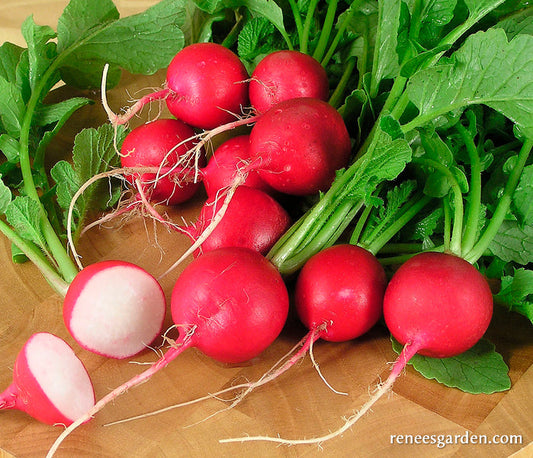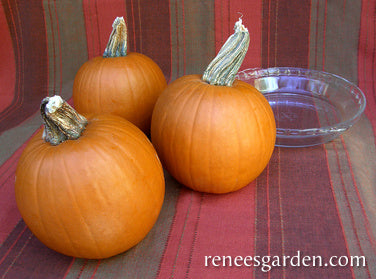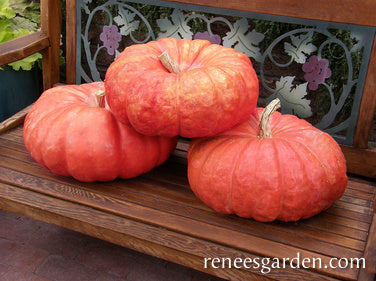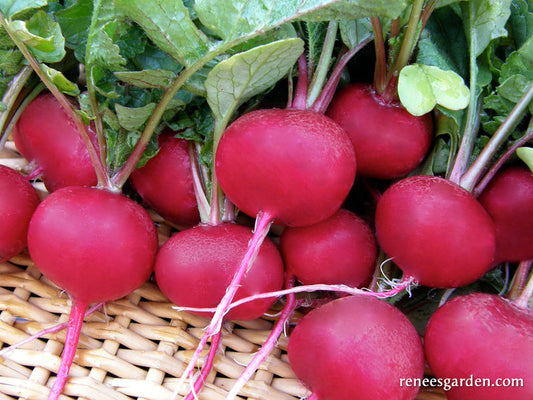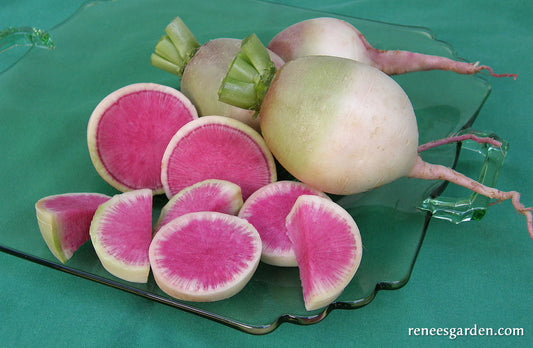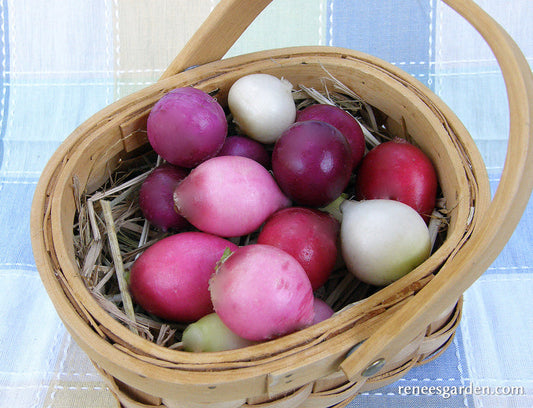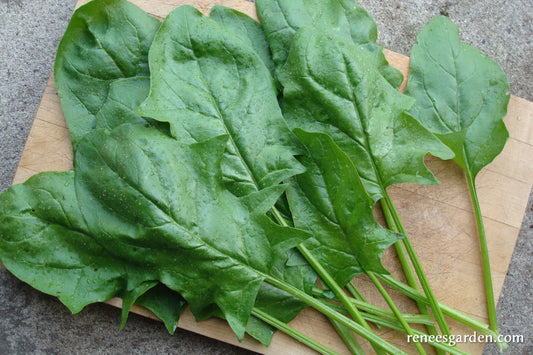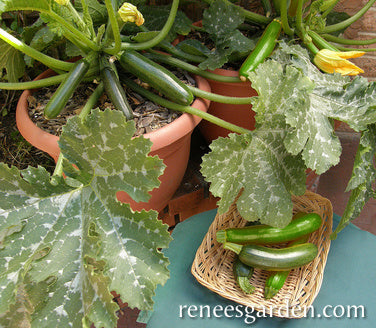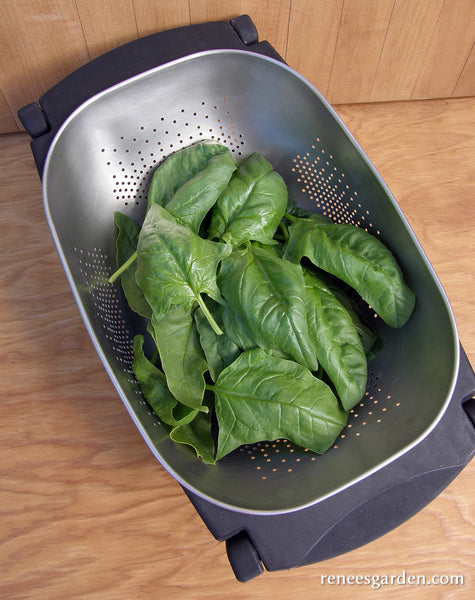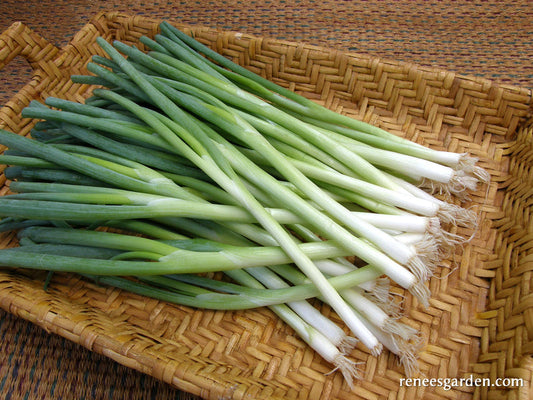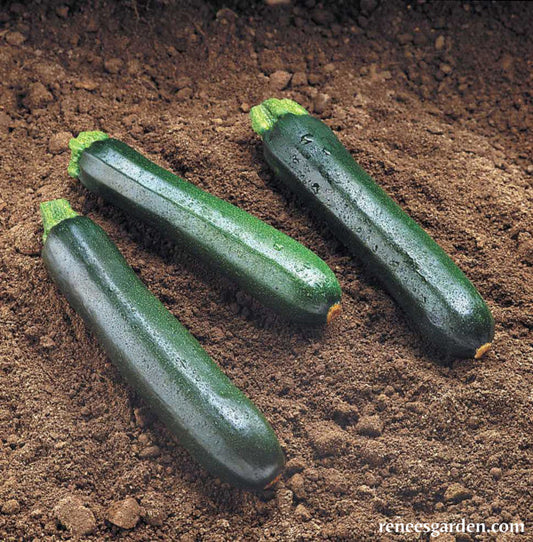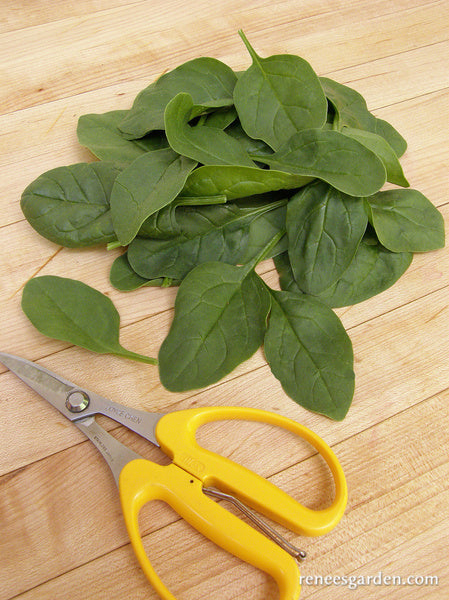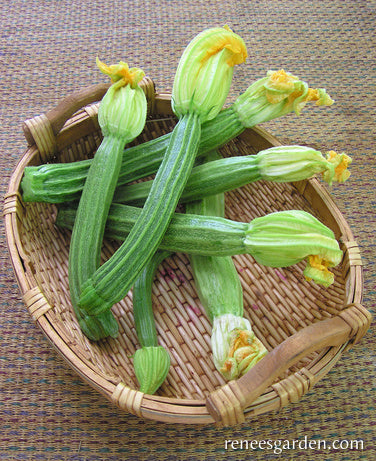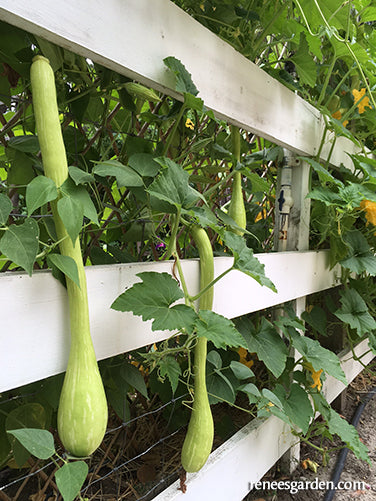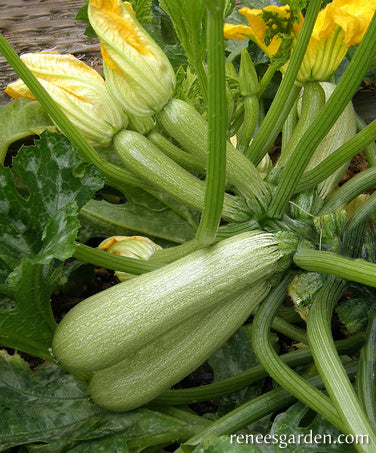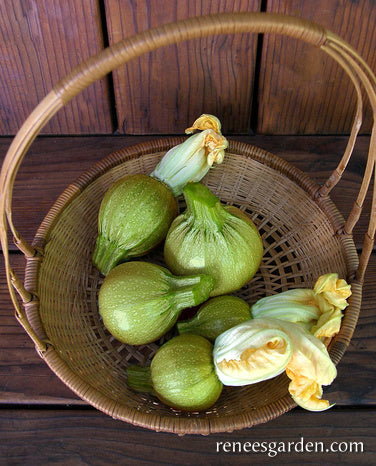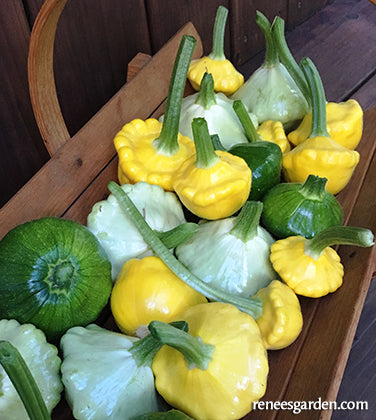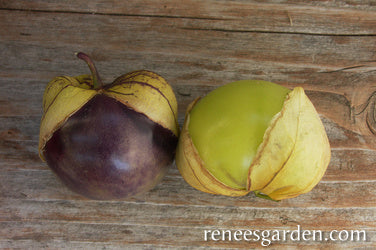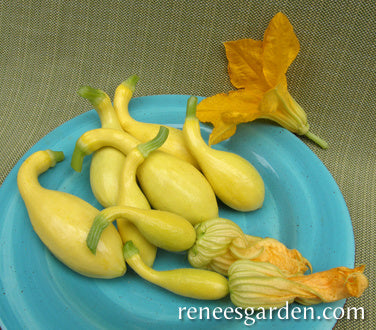Vegetables
Set The Table From Your Garden
-
Round Red Radishes Crimson Crunch
START SEEDS OUTDOORS
In early spring as soon as ground can be worked, sow radish seeds in well-worked, fertile soil in full sun. Space seeds 1 inch apart in wide rows 6 inches apart. Cover 1/2 inch deep. Keep soil evenly moist and well weeded. If first sowing comes up unevenly, replant right away. Sow in late summer for a fall crop.
GROWING NOTES
Sow this quick growing, cool season crop wherever you intend to plant heat lovers later. Radishes thrive and have crisp flesh and the best mild flavor given consistent moisture. Sow small amounts a week apart to mature in warm but not hot weather. Thin quick-growing seedlings early to 2 inches apart so roots have room to size up. Protect radishes with floating row covers if marauding birds or flea beetles that chew holes in the leaves are a problem.
HARVEST AND USE
Harvest radishes when roots are the size of large marbles. If weather turns unexpectedly hot, pull, cut off tops, and store in the refrigerator for up to 3 weeks. Radishes will be spicier in hot weather and milder grown in cooler conditions. Combine sliced radishes, scallions and fresh dill or parsley for a great salad. Make delicious openfaced sandwiches on whole grain bread spread with sweet butter and topped with sliced radishes.
Regular price $3.99Sale price $3.99Unit price / per -
Carving & Pie Pumpkins Spookie
BEST TO START OUTDOORS
Pumpkins need full sun, rich fertile soil and warm temperatures. Wait to plant until temperatures stay above 50°F (10°C) day and night. Sow groups of 2 to 3 seeds 3 feet apart and 1 inch deep in rows 4 feet apart. Thin to 1 strong seedling per group to give vines room to spread. Or, make circular soil mounds 2 to 3 feet across and 8 ft. apart and plant 4 to 5 seeds in each hill. When seedlings have several sets of leaves, thin to 3 seedlings per hill. Protect young seedlings from marauding birds by covering with plastic berry baskets at sowing time, removing before young plants get crowded.
HARVEST AND USE
Pumpkins need to mature properly, so wait to pick until rinds are fully colored and tough enough to resist piercing with a fingernail and vines have died back. Then cut, leaving a good stem handle. Let pumpkins cure for 10 days in the sun, then store in a cool dry place and they'll keep for months. Carve Spookies into happy or scary holiday faces or bake them up into sweet spicy pies, cakes, cookies or savory soups.Regular price $4.89Sale price $4.89Unit price / per -
Heirloom Pumpkins Rouge Vif d'Etampes
BEST TO START OUTDOORS
Pumpkins need full sun, rich fertile soil and warm temperatures. Plant only when weather is warm and night temperatures stay above 50°F (10°C). Sow groups of 3 seeds 3 feet apart and 1 inch deep in rows 4 feet apart. Thin to 1 strong seedling per group. Or, make circular soil mounds 3 feet across. Plant 6 seeds, 6 inches apart in center of each mound. Thin to the strongest 3 seedlings in each mound, so vigorous vines have room to grow and fruit.
GROWING NOTES
Plant pumpkins where the vigorous vines can sprawl. Protect young seedlings from marauding birds by covering with berry baskets at sowing time, removing before plants get crowded. Give vines ample water and feed several times for best yields.
HARVEST AND USE
These big plump beauties need to mature properly before harvest. Wait to pick until their rinds are fully deep orange and tough enough to resist piercing with a fingernail. Cut from vines, leaving good stem handles. Let cure in the sun for 10 days then store in a cool dry place and they’ll keep for months. Steam or bake the rich orange flesh for baked goods, soups or casseroles. Or hollow out the inside and use the ornamental pumpkin whole as a show-stopping serving dish for soup or stew.Regular price $4.89Sale price $4.89Unit price / per -
Heirloom Radishes Pink Beauty
START SEEDS OUTDOORS
In early spring as soon as ground can be worked, sow radish seeds in well-worked, fertile soil in full sun. Space seeds 1 inch apart in rows 6 inches apart. Cover 1/2 inch deep. Keep soil evenly moist and well weeded. If first sowing comes up unevenly, replant right away. Sow again in late summer for a fall crop.
GROWING NOTES
Sow this quick growing, cool season crop wherever you intend to plant heat lovers later. Radishes thrive and have crisp flesh with the best mild flavor given consistent moisture. Sow small amounts a week apart to mature in warm but not hot weather. Thin quick-growing seedlings early to 2 inches apart so roots have room to size up. Protect radishes with floating row covers if marauding birds or flea beetles that chew holes in the leaves are a problem.
HARVEST AND USE
Harvest radishes when roots are the size of large marbles. If weather turns unexpectedly hot, pull, cut off tops, and store in the refrigerator for up to 3 weeks. Radishes will be spicier in hot weather and milder grown in cooler conditions. Combine sliced radishes, scallions and fresh dill or parsley for a great salad. Make delicious open faced sandwiches on whole grain bread spread with sweet butter and topped with sliced radishes.Regular price $4.89Sale price $4.89Unit price / per -
Radishes Red Planet
START SEEDS OUTDOORS
In early spring as soon as ground can be worked, sow radish seeds in well-worked, fertile soil in full sun. Space seeds 1 inch apart in wide rows 6 inches apart. Cover 1/2 inch deep. Keep soil evenly moist and well weeded. If first sowing comes up unevenly, replant right away. Sow again in late summer for a fall crop.
GROWING NOTES
Sow this quick growing, cool season crop wherever you intend to plant heat lovers later. Radishes thrive and have crisp flesh and the best mild flavor given consistent moisture. Sow small amounts a week apart to ensure a constant supply. Thin quick-growing seedlings early to 2 inches apart so roots have room to size up. Protect radishes with floating row covers if marauding birds or flea beetles that chew holes in the leaves are a problem.
HARVEST AND USE
Harvest radishes when roots are the size of large marbles. If weather turns unexpectedly hot, pull, cut off tops, and store in the refrigerator for up to 3 weeks. Radishes will be spicier in hot weather and milder grown in cooler conditions. Combine sliced radishes, scallions and fresh dill or parsley for a great salad. Make delicious open faced sandwiches on whole grain bread spread with sweet butter and topped with sliced radishes.
Regular price $4.89Sale price $4.89Unit price / per -
Heirloom Radishes Watermelon
START SEEDS DIRECTLY OUTDOORS
Plant watermelon radishes at midsummer for fall harvest only. They size up and get sweeter as temperatures drop at the end of the growing season. Sow seeds in well-worked, fertile soil in full sun. Space seeds 1 inch apart, in rows 6 inches apart. Cover 1/2 inch deep. Keep soil evenly moist and well weeded. If the first sowing comes up unevenly, replant right away.
GROWING NOTES
Thin seedlings early to stand 3 inches apart; Watermelon radishes get big, up to three or even four inches in diameter and need room to size up. These Asian-style radishes grow more slowly than spring radishes, so be sure they have consistent moisture for best quality and flavor. Protect with a barrier of floating row cover if marauding birds or insect pests are a problem.
HARVEST AND USE
For best quality, harvest watermelon radishes promptly when sized up 2 to 4 inches in diameter. Note: Interior flesh becomes rosy red when roots are fully mature. Their flavor will be milder and sweeter harvested in cool fall weather. These roots will keep their eating quality for weeks in your refrigerator. For a beautiful and colorful salad, make a plate of very thinly sliced watermelon radishes sprinkled with oil and rice wine vinegar or fresh lemon juice and chopped scallions.Regular price $3.99Sale price $3.99Unit price / per -
Rainbow Radishes Easter Egg II
START SEEDS OUTDOORS
In early spring as soon as ground can be worked, sow radish seeds in well-worked, fertile soil in full sun. Space seeds 1 inch apart in wide rows 6 inches apart. Keep soil evenly moist and well weeded. If first sowing comes up unevenly, replant right away. Sow in late summer for a fall crop.
GROWING NOTES
Sow this quick growing, cool season crop wherever you intend to plant heat lovers later. Radishes thrive and have crisp flesh and the best mild flavor given consistent moisture. Sow small amounts a week apart to mature before or after summer heat. Thin quick-growing seedlings early to 2 inches apart so roots have room to size up. Protect radishes with floating row covers if marauding birds or flea beetles that chew holes in the leaves are a problem.
HARVEST AND USE
Harvest radishes when roots are the size of large marbles. If weather turns unexpectedly hot, pull, cut off tops, and store in the refrigerator for up to 3 weeks. Radishes will be spicier in hot weather and milder grown in cooler conditions. Combine sliced radishes, scallions and fresh dill or parsley for a great salad. Make delicious open faced sandwiches on whole grain bread spread with sweet butter and topped with sliced radishes.Regular price $3.39Sale price $3.39Unit price / per -
Baby Salad Spinach Regiment
TO START OUTDOORS
In early spring when danger of hard frost is over, sow seeds in well-worked fertile soil in full sun. Space seeds 1 inch apart in rows 8 to 10 inches apart, or broadcast thinly for bed planting. Be sure to firm soil well over seeds to ensure good germination. If first sowing germinates unevenly, plant more seeds as they will catch up fast.
GROWING NOTES
Spinach is most productive grown in cool spring conditions and sown again in late summer for a fall crop. After seedlings reach 2 to 3 inches tall, thin out every other plant (and enjoy in early salads) and keep thinning in this fashion until plants are spaced 5 or 6 inches apart. Keep the shallow rooted plants well weeded and watered. Spinach is a heavy feeder so fertilize several times with fish emulsion solution for best harvests.
HARVEST AND USE
There are two methods for harvesting spinach: either cut the entire plant 1 inch or so above the base once plants are 4 or 5 inches tall, or wait until plants are well established and harvest just the outer leaves, leaving at least 4 center leaves so plant will continue to grow. Water and fertilize after cutting and plants will provide 2 or 3 pickings before weather gets too warm and spinach begins to go to seed.Regular price $4.89Sale price $4.89Unit price / per -
Japanese Spinach Oriental Giant
TO START OUTDOORS
In early spring when danger of hard frost is over, sow seeds in well-worked fertile soil in full sun. Space seeds 1 inch apart in rows 8 to 10 inches apart, or broadcast thinly for bed planting. Cover with 1/2 inch of soil; firm soil over seeds to ensure good germination. If first sowing germinates unevenly, plant more seeds as they will catch up fast.
GROWING NOTES
Spinach is most productive grown in cool spring conditions and sown again in late summer for a fall crop. After seedlings reach 2 to 3 inches tall, thin out every other plant (and enjoy in early salads) and keep thinning in this fashion until plants are spaced 8 or 10 inches apart. Keep the shallow-rooted plants well weeded and watered. Spinach is a heavy feeder so fertilize several times with a high nitrogen source like fish emulsion solution for best harvests.
HARVEST AND USE
Wait until plants are well established and harvest just the outer leaves, leaving at least 4 younger center leaves so plant will continue to grow. Water and fertilize after cutting and plants will provide 2 or 3 pickings before weather gets too warm and spinach begins to go to seed. Plant again in late summer to early fall for a succulent autumn crop.
Regular price $3.39Sale price $3.39Unit price / per -
Container Zucchini Astia
START SEEDS OUTDOORS
Plant only when weather has warmed up and nights are above 50°F (10°C) Amend soil well with aged manure or compost. In a sunny spot, make slightly mounded hills, 3’ wide and 3’ apart. Sow seeds in a triangle on each mound, planting two seeds 1” deep at each point in the triangle. Thin to the strongest seedling at each point, leaving 3 seedlings per mound.
FOR CONTAINERS
Use fresh, good quality potting soil in containers. For a pot 15 in. across and 12 in. deep, sow 2-3 seeds in center. When seedlings reach 3-4 inches, remove all but 1 strong seedling. For pots 18-20 in. across and 12-15 in. deep, sow seeds 4 inches from container edges, then thin to 2 plants per pot. For larger pots, thin plants to be 8 in. apart. Mulch to help conserve moisture and fertilize monthly for good production. In hot weather, check and water containers daily.
GROWING NOTES
Protect seedlings from marauding birds with plastic berry baskets, removing before plants get crowded. Thin plants properly; you’ll get more zucchinis from a few well-spaced, healthy vines than from crowded plants that are much more disease prone.
HARVEST AND USE
Harvest at about 5 inches in length; frequent harvesting keeps plants producing. Enjoy these zucchinis grilled, baked sautéed or steamed. Try slicing lengthwise, drizzling with olive oil and roasting to succulent perfection. Or slice 1/2 inch thick, top with pizza sauce and cheese and bake.Regular price $4.99Sale price $4.99Unit price / per -
French Breakfast Radishes Petit Dejeuner
START SEEDS OUTDOORS
In early spring as soon as ground can be worked, sow radish seeds in well-worked, fertile soil in full sun. Space seeds 1 inch apart in wide rows 6 inches apart. Keep soil evenly moist and well weeded. If first sowing comes up unevenly, replant right away. Sow in late summer for a fall crop.
GROWING NOTES
Sow this quick cool season crop wherever you intend to plant heat lovers later. Radishes thrive with crisp flesh and mild flavor when given consistent moisture. Sow small amounts a week apart to mature in warm but not hot weather. Thin quick-growing seedlings early to 2 inches apart so roots have room to size up. Protect radishes with floating row covers if marauding birds or flea beetles that chew holes in the leaves are a problem.
HARVEST AND USE
Pull young round roots at large marble size and cylindrical ones at 2 to 3 inches long. If weather turns hot, harvest, cut off tops and store in fridge. Radishes’ flavor is mildest in cool weather, spicier in hot conditions. Picked young and tender, these refined French treats make crispy snacks or attractive appetizers, and add appealing color and crunch to green salads. Especially delicious sliced and tossed with a sesame flavored dressing.Regular price $2.99Sale price $2.99Unit price / per -
Long-Standing Spinach Summer Perfection
TO START OUTDOORS
In early spring when danger of hard frost is over, sow seeds in well-worked fertile soil in full sun. Sow seeds 1 inch apart and 1/2 inch deep in rows 10 inches apart, or broadcast thinly for bed planting. Be sure to firm soil well over seeds to ensure good germination. If first sowing germinates unevenly, plant more seeds as they will catch up fast.
GROWING NOTES
Spinach is most productive grown in cool spring conditions and sown again in late summer for a fall crop. After seedlings reach 2 to 3 inches tall, thin out every other plant (and enjoy in early salads) and keep thinning in this fashion until plants are spaced 5 or 6 inches apart. Keep the shallow rooted plants well weeded and watered. Spinach is a heavy feeder so fertilize several times with fish emulsion solution for best harvests.
HARVEST AND USE
There are two methods for harvesting spinach: either cut the entire plant 1 inch or so above the base once plants are 4 or 5 inches tall, or wait until plants are well established and harvest just the outer leaves, leaving at least 4 center leaves so plant will continue to grow. Water and fertilize after cutting and plants will provide 2 or 3 pickings before weather gets too warm and spinach begins to go to seed.
Regular price $3.39Sale price $3.39Unit price / per -
Salad Scallions Sprint
EASIEST TO START OUTDOORS
Plant scallions throughout the spring and again in mid to late summer for fall harvests. Sow seeds in well-worked, fertile soil in full sun. Space seeds 1 inch apart in rows 8 to 10 inches apart, or broadcast thinly for bed planting. Cover 1/2 inch deep and firm soil well over seeds. Be sure to keep soil evenly moist to ensure good germination.
THIN OR TRANSPLANT
Space 1 to 2 inches apart, allowing plants room to mature.
GROWING NOTES
Scallions take up little garden space, so tuck several rows around beds of lettuce, spinach or radishes. Make several plantings a month apart to have a constant supply for spring and summer meals. Prepare soil well with lots of aged manure or compost before planting. Keep evenly moist and weed carefully when plants are young. Mulching to conserve soil moisture and suppress weed growth is a good strategy.
HARVEST AND USE
To get the most out of your crop, start by using tender, mild-flavored early thinnings in salads, then continue thinning gradually so mature scallions stand an inch or two apart. These tasty scallions are best if harvested at 10 to 12 inches tall or before they send up bloom stalks, which makes the stems turn tough and too spicy.
Regular price $4.89Sale price $4.89Unit price / per -
Salad Scallions Delicious Duo
EASIEST TO START OUTDOORS
Plant scallions throughout the spring and again in mid to late summer for fall harvests. Sow seeds in well-worked, fertile soil in full sun. Space seeds 1 inch apart in rows 8 to 10 inches apart, or broadcast evenly for bed planting. Cover 1/2 inch deep and firm soil well over seeds. Be sure to keep soil evenly moist to ensure good germination.
THIN OR TRANSPLANT
Space 1 to 2 inches apart, allowing plants room to mature.
GROWING NOTES
Scallions take up little garden space, so tuck several rows around beds of lettuce, spinach or radishes. Make several plantings a month apart to have a constant supply for spring and summer meals. Prepare soil well with lots of aged manure or compost before planting. Keep evenly moist and weed carefully when plants are young. Mulching to conserve soil moisture and suppress weed growth is a good strategy.
HARVEST AND USE
To get the most out of your crop, start by using tender, mild-flavored early thinnings in salads, then continue thinning gradually so mature scallions stand an inch or two apart. These colorful scallions are best if harvested at 10 to 12 inches tall or before they send up bloom stalks, which makes the stems turn tough and too spicy.Regular price $3.99Sale price $3.99Unit price / per -
Salad Scallions Parade
EASIEST TO START OUTDOORS
Plant scallions throughout the spring and again in mid to late summer for fall harvests. Sow seeds in well-worked, fertile soil in full sun. Space seeds 1 inch apart in rows 8 to 10 inches apart, or broadcast thinly for bed planting. Cover 1/4 inch deep and firm soil well over seeds. Be sure to keep soil evenly moist to ensure good germination.
THIN OR TRANSPLANT
Space 1 to 2 inches apart, allowing plants room to mature.
GROWING NOTES
Scallions take up little garden space, so tuck several rows around beds of lettuce, spinach or radishes. Make several plantings a month apart to have a constant supply for spring and summer meals. Prepare soil well with lots of aged manure or compost before planting. Keep evenly moist and weed carefully when plants are young. Mulching to conserve soil moisture and suppress weed growth is a good strategy.
HARVEST AND USE
To get the most out of your crop, start by using tender, mild-flavored early thinnings in salads, then continue thinning gradually so mature scallions stand an inch or two apart. These tasty scallions are best if harvested at 10 to 12 inches tall or before they send up bloom stalks, which makes the stems turn tough and too spicy.Regular price $3.99Sale price $3.99Unit price / per -
Dark Green Zucchini Twilight
START SEEDS DIRECTLY IN THE GARDEN
Zucchini vines need full sun, rich fertile soil and warm temperatures. Plant only when spring weather is warm and settled and both day and night temperatures stay above 50°F (10°C). Sow 2 to 3 seeds 1 inch deep in groups 1 1/2 feet apart. Thin to 1 seedling per group. Alternatively, plant in slightly mounded hills, 3 feet in diameter and 3 feet apart. Sow 5 or 6 seeds in each hill 6 inches apart. When seedlings are several inches tall, thin to the 2 or 3 strongest plants in each hill.
GROWING NOTES
Amend garden soil well with lots of aged manure or compost before sowing. Protect young seedlings from marauding birds by covering with plastic berry baskets at planting time, removing when plants get crowded. Be sure to thin properly; you’ll get more zucchini from two or three well-spaced plants as from more crowded and thus disease prone ones. Covering plants with floating row covers will help prevent squash borers if these pests are a problem in your area.
HARVEST AND USE
Dark green Twilight are easy to find and pick. Harvest when young, no larger than 5 inches in length; all zucchini lose flavor and quality with size. Frequent harvesting keeps plants producing tasty new fruits all season long. Tender-fleshed and delicate, Twilight zucchini are scrumptious simply steamed or sliced lengthwise and grilled on the barbecue.
Regular price $4.39Sale price $4.39Unit price / per -
Baby Leaf Spinach Catalina
TO START OUTDOORS
In early spring when danger of hard frost is over, sow seeds in well-worked fertile soil in full sun. Space seeds 1 inch apart in rows 8 to 10 inches apart, or broadcast thinly for bed planting. Firm soil well over seeds to ensure good germination. If first sowing germinates unevenly, plant more seed as seedlings will catch up fast. Sow again in late summer.GROWING NOTES
Spinach is most productive in cool weather. Grow in cool spring conditions and sow again in late summer for a productive fall crop. After seedlings reach 2 to 3 inches tall, thin out every other plant (and enjoy in early salads) and keep thinning in this fashion until plants are spaced 5 or 6 inches apart.HARVEST AND USE
Either harvest individual outside leaves from well-established plants and let regrow, or harvest entire plants. Keep spinach plants well watered and weeded and fertilize these heavy feeders several times as they leaf out and especially after harvesting outside leaves. Combine well-washed and dried leaves with your favorite garlicky salad dressing; spinach pairs well with hearty dressings like the traditional hot bacon dressing. Good spinach salad additions include thinly sliced sweet red onions, sliced radishes, thin wedges of red apple or orange segments, toasted nutmeats, chopped scallions, crispy bacon bits, hard-cooked egg quarters and finely grated hard cheese.
Regular price $3.99Sale price $3.99Unit price / per -
Italian Zucchini Romanesco
START SEEDS OUTDOORS
Summer squash needs full sun, rich fertile soil and warm temperatures. Plant only when spring weather is warm and settled and night temperatures stay above 50°F (10°C). Sow groups of 2 to 3 seeds 1 inch deep and 2 feet apart, in rows 3 feet apart. Thin to 1 strong seedling per group. Or, make slightly mounded hills, 2 feet in diameter and 3 feet apart, sowing 5 or 6 seeds in each hill. When seedlings are several inches long, thin hill-planted seedlings to the 2 strongest plants per hill.
GROWING NOTES
Amend soil well before sowing with lots of aged manure or compost. Protect young seedlings from marauding birds by covering with green plastic berry baskets at planting time, removing when plants get crowded. Be sure to thin properly — you will have more productive, disease-free plants if seedlings have enough room to mature.
HARVEST AND USE
For succulent texture and best flavor, pick Romanesco when no more than 6 to 8 inches long. Frequent harvesting keeps plants producing tasty new fruits over a longer season. Slice lengthwise, brush with olive oil and grill until tender, then sprinkle with your favorite chopped herbs. Or combine chunks of Romanesco, onion, peppers and whole garlic cloves, toss with a little oil and bake in the oven until tender.Regular price $4.39Sale price $4.39Unit price / per -
Heirloom Climbing Summer Squash Trombetta di Albenga
START SEEDS OUTDOORS
Squash needs full sun, rich fertile soil and warm temperatures. Plant only when spring weather is warm and settled and night temperatures stay above 55°F (13°C). Train vigorous Trombetta vines up 6 to 8 foot stakes or a fence or trellis where they will make a lush leafy arbor or canopy and save garden space. Plant in full sun, sowing groups of 2-3 seeds 1 inch deep and 4 inches from vertical supports. Thin to the strongest seedling for each pole or to 12 inches apart along a fence.
GROWING NOTES
Amend soil well before sowing with lots of aged manure or compost. Protect young seedlings from marauding birds by covering with plastic berry baskets at planting time, removing when plants get crowded. Thin properly to get best quality fruits and highest yield. As young plants grow, tie them to supports.
HARVEST AND USE
Softly curved, lime-green Trombetta squashes are best harvested no longer than 10 to 12 inches long and as thick around as cucumbers. Sauté or stuff them, or use in any of your favorite summer squash recipes. Cook until just tender to enjoy their fine flavor and texture.Regular price $3.69Sale price $3.69Unit price / per -
Heirloom Italian Zucchini Ortolana di Faenza
START SEEDS OUTDOORS
Zucchinis need full sun, rich fertile soil and warm temperatures. Plant only when spring weather is warm and night temperatures stay above 50°F (10°C). Sow groups of 2 to 3 seeds,1 inch deep, every 2 feet, in rows 3 feet apart. Thin to leave only 1 seedling every 2 feet. Or, plant in slightly mounded hills, 2 feet in diameter, sowing 5 or 6 seeds in each hill. Thin hill-planted seedlings to 2 or 3 strongest plants.
GROWING NOTES
Amend soil well before sowing with lots of aged manure or compost. Protect young seedlings from marauding birds by covering with plastic berry baskets at planting time, removing when plants get crowded. Be sure to thin properly — you will have more productive, disease-free plants if seedlings have enough room to mature.
HARVEST AND USE
Harvest zucchini when no more than 5 to 6 inches long for best flavor. Frequent harvesting keeps plants producing tasty new fruits instead of maturing fat, tough, huge ones. Steam, stir-fry or grill sliced zucchinis and sprinkle with fresh parsley, dill, basil or thyme. Try the tasty blossoms sautéed or stuffed and baked. Heap a platter with spears of baby zucchinis to serve with your favorite dip for appetizers or snacks.Regular price $4.89Sale price $4.89Unit price / per -
Heirloom French Zucchini Ronde de Nice
START SEEDS OUTDOORS
Zucchinis need full sun, rich fertile soil and warm temperatures. Plant only when spring weather is warm and settled and night temperatures stay above 50°F (10°C). Sow groups of 2 to 3 seeds 1 inch deep and 2 feet apart. When seedlings have 4 leaves, thin to 1 strong seedling per group. Or, plant in slightly mounded hills, 2 feet in diameter, sowing 4 or 5 seeds in each hill. Thin hill-planted seedlings to the 2 or 3 strongest plants.
GROWING NOTES
Amend soil well before sowing with lots of aged manure or compost. Protect young seedlings from marauding birds by covering with plastic berry baskets at planting time, removing when plants get crowded. Be sure to thin properly – you will have more productive, disease-free plants if seedlings have enough room to mature.
HARVEST AND USE
Harvest Ronde de Nice as delicate babies when they reach just 1 or 2 inches in diameter or let grow to no more than 4 to 5 inches to enjoy best flavor and texture. Cook the little globes until just tender in a little butter and chicken broth and add your favorite chopped fresh herbs. Hollow out bigger squashes and chop up flesh, then combine with your favorite stuffing ingredients, fill the shells and bake to savory perfection.Regular price $4.89Sale price $4.89Unit price / per -
Tricolor Pattypan Squash Summer Scallop Trio
START SEEDS OUTDOORS
Squash needs full sun, rich fertile soil and warm temperatures. Plant only when spring weather is warm and settled and night temperatures stay above 50°F (10°C). Sow groups of 2 to 3 seeds 1 inch deep and 1 1/2 feet apart in rows 2 feet apart. When several inches long, thin to 1 strong seedling per group. Or, plant in slightly mounded hills, 2 feet in diameter and 2 feet apart. Sow 5 to 6 seeds 1 inch deep and 4 inches apart in each hill. When seedlings are several inches long, thin hill-planted seedlings to the 2 strongest plants so they have ample room to grow.
HARVEST AND USE
Harvest scallops when no more than 2 to 3 inches across for best flavor and tenderness. Frequent harvesting keeps plants producing tasty new squashes instead of maturing large, tough and pithy ones. Steam or stir fry the little pattypans and sprinkle with chopped fresh herbs like chives, basil, finely snipped dill or lemon basil. Cook and toss all 3 jewel-toned squashes with freshly ground pepper, butter and grated Parmesan.
GROWING NOTES
Amend soil well before sowing with lots of aged manure or compost. Protect young seedlings from marauding birds by covering with green plastic berry baskets at planting time, removing when plants get crowded. Be sure to thin properly — you will have more productive, disease-free plants if seedlings have enough room to mature.Regular price $4.39Sale price $4.39Unit price / per -
Mexican Tomatillos Two Color Fiesta
BEST TO START INDOORS
In early spring, start indoors about 6 weeks before outdoor night temperatures are reliably in the 50-55°F (10-13°C) range. Sow seeds 1/4 inch deep and 1 inch apart in containers of seed starting mix. Keep moist but not soggy and very warm 75-80°F (24-27°C). Provide a strong light source until seedlings are ready to plant outside. When seedlings are 2 inches tall, transplant into 4 inch individual pots. Maintain at 70-75°F (21- 24°C). Feed with half-strength fertilizer every 2 weeks until weather is warm enough to gradually acclimate seedlings to outdoor conditions. Transplant 3 feet apart into rich soil in full sun once nights stay securely above 55°F (13°C).
GROWING NOTES
Prepare soil well with aged manure or compost. Provide strong stakes or wire cages at planting time, or tomatillos can spread over the ground if you have lots of space; they are vining plants similar to tomato vines. Mulch well to keep fruit clean and conserve moisture; don't overwater once fruits begin to ripen.
HARVEST AND USE
At first, tomatillo fruits look like little green balloons. As the fruit inside sizes up, they resemble cherry tomatoes surrounded by a papery husk. Pick when plump fruits fill out the husks and begin to break open, usually at 1 to 1 1/2 inches, but before fruits begin to turn yellow or soften.
Regular price $3.39Sale price $3.39Unit price / per -
Crookneck Squash Sunny Supersett
START SEEDS OUTDOORS
Summer squash needs full sun, rich fertile soil and warm temperatures. Plant only when spring weather is warm and settled and nights are above 50°F (10°C). Sow groups of 3 seeds 1 inch deep and 1 foot apart, in rows 3 feet apart. Thin to 1 strong seedling per group. Or, plant in slightly mounded hills, 2 feet in diameter and 2 feet apart, sowing 5 or 6 seeds in each hill. When seedlings are several inches long, it is critical to thin hill-planted seedlings to the 2 strongest plants so they have ample room to grow.
GROWING NOTES
Amend soil well before sowing with lots of aged manure or compost. Protect young seedlings from marauding birds by covering with green plastic berry baskets at planting time, removing when plants get crowded. Be sure to thin properly — you will have more productive, disease-free plants if seedlings have enough room to mature.
HARVEST AND USE
For succulent texture and best flavor, pick Supersett crooknecks when they are no more than 4 to 6 inches long. Frequent harvesting keeps plants producing tasty new fruits all season long. These little squashes shine when freshly picked and simply steamed or poached in broth to serve with fresh herb butter.
Regular price $3.99Sale price $3.99Unit price / per

